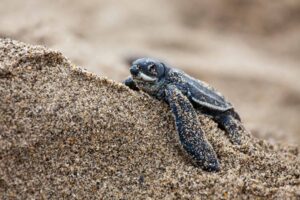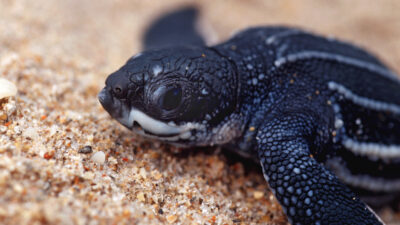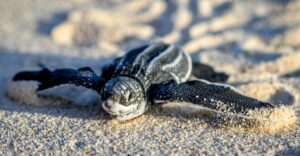The leatherback turtle (Dermochelys coriacea) is the largest species of sea turtle and is known for its unique feeding habits. Unlike other sea turtles, leatherbacks have a distinctive, specialized diet primarily consisting of jellyfish.
Here are some key aspects of their feeding behavior:
- Jellyfish Diet:
- Leatherback turtles are predominantly jellyfish eaters, and their diet can consist of various species of jellyfish.
- They have specialized adaptations in their mouths to help them consume jellyfish. Their jaws are filled with sharp, pointed cusps that aid in grasping slippery prey.
- Feeding Areas:
- Leatherbacks are highly migratory and can cover vast distances in search of food. They are known to travel across entire ocean basins.
- Their feeding areas can vary, but leatherbacks are often found in open ocean environments, particularly in pelagic zones where jellyfish are abundant.
- Deep Diving:
- Leatherback turtles are capable of deep dives, and they can reach depths of over 1,000 meters (3,280 feet) in search of prey.
- These deep dives allow them to access areas where jellyfish may be concentrated, and they are adapted to both shallow and deep-water environments.
- Thermoregulation:
- Leatherbacks are unique among sea turtles in that they have a more extensive distribution, and they are known to inhabit colder waters compared to other species.
- Their large size, streamlined body, and unique ability to regulate their body temperature internally allow them to venture into cooler regions where jellyfish may be more abundant.
- Filter Feeding Adaptations:
- Leatherbacks have been observed using a filter-feeding method to consume large quantities of jellyfish. They open their mouths widely, allowing water to flow in, and then expel the excess water through openings on the sides of their mouths, retaining the jellyfish for consumption.
- Impact of Human Activities:
- Leatherback turtles face numerous threats, including entanglement in fishing gear and ingestion of marine debris, which can be mistaken for their jellyfish prey. Plastic bags, in particular, can be a serious threat as leatherbacks may mistake them for jellyfish and ingest them accidentally.
Understanding the leatherback turtle’s feeding behavior is crucial for conservation efforts, as these animals face numerous challenges in the marine environment, including habitat loss, pollution, and accidental capture in fishing gear. Conservation initiatives aim to address these threats and protect leatherback turtles and their ecosystems.
What Do Leatherback Turtles Eat?

Leatherback turtles primarily feed on jellyfish, and their diet is specialized to include various species of gelatinous organisms. While jellyfish are the primary food source for leatherback turtles, they may also consume other soft-bodied organisms found in the ocean. Here are some details about the leatherback turtle’s diet:
- Jellyfish:
- Jellyfish make up the bulk of the leatherback turtle’s diet. They are known to consume a variety of jellyfish species, and their feeding habits are adapted to capturing and consuming these gelatinous organisms.
- Leatherbacks have pointed cusps in their mouths that help them grasp and swallow jellyfish efficiently.
- Salps and Comb Jellies:
- In addition to jellyfish, leatherback turtles may also feed on other gelatinous organisms, such as salps and comb jellies. These organisms are also soft-bodied and may be encountered in the open ocean.
- Invertebrates:
- While jellyfish are the primary prey, leatherback turtles may occasionally consume other soft-bodied invertebrates, such as tunicates and sea anemones.
- Filter Feeding:
- Leatherbacks are known to use a filter-feeding method to consume their prey. They open their mouths wide, allowing water to flow in, and then expel the excess water through openings on the sides of their mouths. This allows them to retain the jellyfish or other gelatinous prey while expelling water.
It’s important to note that leatherback turtles are highly specialized for a diet of gelatinous organisms, and their feeding behavior reflects adaptations to capture and consume such prey efficiently. As apex predators in their ecosystem, leatherbacks play a crucial role in controlling jellyfish populations, helping to maintain the balance of marine ecosystems.
Factors Affecting Leatherback Turtle Diet
The leatherback turtle (Dermochelys coriacea) is the largest of all sea turtle species and is known for its unique characteristics, including a distinct leather-like shell and a diet that primarily consists of jellyfish. The factors affecting the leatherback turtle’s diet are diverse and can include biological, environmental, and ecological influences.
Here are some key factors:
- Location and Habitat:
- Oceanic vs. Coastal Regions: Leatherback turtles can be found in both oceanic and coastal environments. The availability of specific prey, including jellyfish, can vary between these habitats.
- Temperature and Currents: Ocean temperatures and currents influence the distribution and abundance of jellyfish, a primary food source for leatherbacks.
- Prey Availability:
- Jellyfish Abundance: Leatherback turtles primarily feed on jellyfish. The abundance and distribution of jellyfish in a particular area strongly influence the leatherback’s feeding opportunities.
- Seasonal Variation: Jellyfish populations can exhibit seasonal fluctuations, affecting the leatherback turtle’s diet throughout the year.
- Migration Patterns:
- Long-Distance Migration: Leatherback turtles are known for their long-distance migrations. Their feeding habits can be influenced by the locations they migrate to, where the availability of jellyfish may differ.
- Oceanographic Conditions:
- Upwelling Zones: Areas with upwelling, where nutrient-rich waters rise to the surface, can support increased productivity and influence the distribution of prey species.
- Eddies and Gyres: Oceanic features like eddies and gyres can concentrate prey, affecting the foraging behavior of leatherback turtles.
- Life Stage:
- Ontogenetic Shifts: Leatherback turtles undergo ontogenetic shifts in their diet as they grow. Juveniles may feed on different prey items than adults, and this shift can be influenced by factors such as size and energy requirements.
- Human Activities:
- Fishing Gear and Debris: Leatherback turtles can accidentally ingest plastic debris, including bags, which may resemble their jellyfish prey. This can lead to ingestion of harmful materials and potential impacts on their health.
- Climate Change:
- Temperature Changes: Climate change can influence ocean temperatures, affecting the distribution and abundance of prey species. Changes in sea temperature may also impact the metabolic rates of leatherback turtles.
- Conservation Efforts:
- Protected Areas: The establishment of marine protected areas can play a role in preserving the habitats where leatherback turtles forage, ensuring the availability of suitable prey.
Understanding the complex interplay of these factors is crucial for the conservation of leatherback turtles, as alterations in their environment can have significant impacts on their feeding ecology and overall well-being.
Threats to leatherback turtle diet



